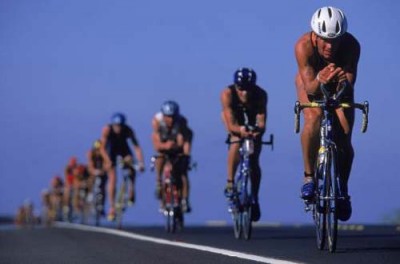
As an indoor cycling instructor, you”™re going to find a large percentage of your students dabble in triathlon, or engage in it as a serious sport. Either way, you don”™t want to be embarrassed by using the wrong triathlon-related words or terms in your class when talking to them about triathlon (including the ever-popular pronunciation of triathlon as “triath-a-lon”).
So to help you look better and converse intelligently and confidently with your indoor cycling students who are triathletes, this is Part 5 of a five part series called “Tri-Lingo 101” that will teach you how to use the correct triathlon terms. In this article, you”™ll learn common triathlon race terms. Without further ado, let”™s dive in!
Aid Station: Typically every 1 mile to 1K on the run and every 10-20 miles on the bike, there will be an aid station with gels and water. Plan for these when packing your race fuel and hydration.
Marshall: Typically one or several individuals are on the course, ensuring that the rules are followed, and flashing penalty cards at individuals who do not follow the rules. On the bike course, they are usually on scooters or motorcycles. These vehicles are legally permitted to be on the race course and are there for your safety.
Pack: A group of cyclists that forms during the race. It is possible, if each cyclist is separated by 10 meters, for this to be a legal form of racing in a non-draft legal race, but in many cases “illegal” packs form.
Penalty: During a race, if you are caught illegally drafting, littering, cutting the course, passing on the wrong side of the road, or committing any other activity that has been banned by the race director or officiating body, you will serve a penalty, which is typically A) stopping your bike, waiting, and then starting again; B) stopping for 2-5 minutes in a penalty tent; or C) having time added to your finishing time.
Penalty Tent: Also known as the “Sin Bin”, these are commonly seen in Half-Ironman and Ironman events, and are where you must stop to complete several minutes of penalty time if you are caught drafting or littering.
Podium: Typically the first 3-5 competitors in each age group qualify for a podium finish, which typically receives some type of trophy, medal or certificate in addition to a finisher”™s certificate.
Slot: In any races that are “qualifiers” for any type of championship, such as Hawaii Ironman World Championships, there are a limited number of allocated slots that are given to the fastest triathletes. Many times, people will wait for the “roll-down” if they did not get a “slot”, which means they may be able to take slots that qualifying athletes turned down.
Special Needs: During an Ironman distance triathlon, there is a point about halfway through the bike and halfway through the run where you can collect a special bag that you have pre-packed with any needs you may have. The bag is given to you by volunteers.
Volunteer: These individuals are not paid and volunteer to do things like building transition area, handing out aid, timing the race, giving out medals, and even working in the medical tent. Smile at them and thank them!
Bio:
Ben is a fitness business coach, triathlon author, and sports nutritionist. If you want more videos, aricles and audios about swimming and other triathlon related topics, visit Ben”™s free blog and podcast at http://www.bengreenfieldfitness.com . Also be sure to check out Ben”™s endurance sports website Endurance Planet, at http://www.enduranceplanet.com and his Rock Star Triathlete Academy, at http://www.rockstartriathlete.com . Finally, if you want to learn how to grow your fitness business and make more money, visit Ben”™s fitness business advice website at http://www.trainfortopdollar.com .
- Tri-Lingo 101 — Part 1: Common Triathlon Swim Terms - September 4, 2019
- Tri-Lingo 101 — Part 5: Common Triathlon Race Terms - March 16, 2011
- Tri-Lingo 101 — Part 2: Common Triathlon Bike Terms - February 13, 2011
